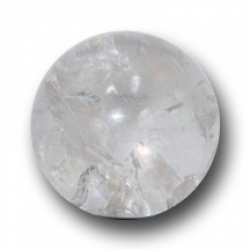Quartz (rock crystal)

Compared to most of its gemstone cousins, quartz is not particularly valuable. Rarity is a significant factor in the monetary worth of many gemstones, and as one of the most abundant materials in the Earth’s crust, quartz doesn’t quite measure up in this regard. On the other hand, quartz is still a rather fascinating stone in its own right, both in terms of physical nature and symbolic importance.
One important thing to understand about quartz is its diversity. “Quartz” is actually an umbrella term that can refer to a number of specific substances. Amethyst, the famous deep purple stone, is a form of quartz and the most valuable member of the family. Other members include citrine (a yellow variety), smoky quartz (colored brown/grey/black) as well as the famous rose quartz (tinted pale pink). Although some of these forms can have notable monetary value, in terms of symbolic importance, clear quartz - also known as “rock crystal” - is the most significant and will be the primary focus of this article.
First, let’s talk etymology. The word “crystal” comes from the Greek “kurstallos” (spellings vary) meaning ‘ice’, and this ties into one of the material’s symbolic meanings. The ancient Greeks believed rock crystal was ice that had been frozen forever by the gods. For the Romans, this symbolism was even more pronounced. Whether ground into powder or fashioned as an amulet, rock crystal was used to cool hot skin and to treat conditions such as fevers. It was also believed that nursing mothers should wear the material as a way to help ease the flow of their milk.
Two of the most famous uses of rock crystal were in the fields of divination and spiritual healing. Possibly due to its transparency, clear quartz was seen as a symbol of purity and clarity, and as such was the ideal material from which to fashion crystal balls (this purity/clarity factor could also mean a clear mind). Because crystals are particularly adept at manipulating and redirecting rays of light, they were seen as able to absorb and control energy, and in that capacity found popular use as healing instruments. This manipulation of light was also seen as capturing ‘divine rays’, adding a more spiritual spin to the phenomenon.
In Japan, pieces of rock crystal were believed to be the congealed breath or saliva of dragons, and the Aborigines of Australia also held the substance in high esteem. In modern times, crystals are used as manufacturing components in glass, ceramics and all manner of electronic devices. The latter is due to the material’s electrical conductivity, and the resulting frequencies it produces have proved to be very stable and balanced.
© Symbols.com
